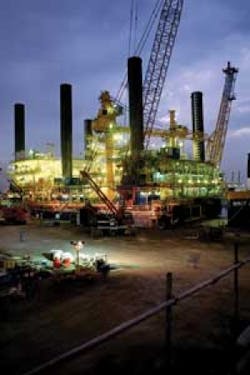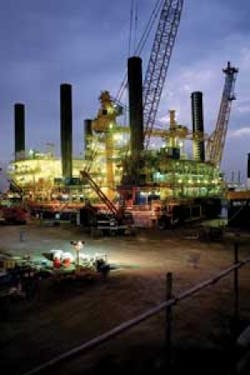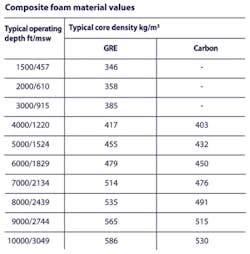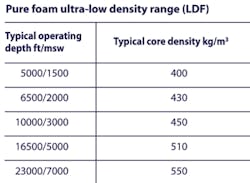Syntactic foam takes ROVS to deeper depths
Testing makes for confident deployment
Dr. Bob Oram
Balmoral Offshore Engineering
The rapid pace of development of drillship design now allows drilling in water depths beyond the traditional 10,000 ft/3,000 msw (meters of sea water) barrier. The certainty of finding commercial reservoirs in these extreme water depths has driven parallel development programs in all areas of subsea equipment associated with deepwater oil production.
The availability of ROVs and AUVs with matching depth capability also is essential. While newbuild deepwater ROVs traditionally are specified with a 3,000 msw operating depth rating, the growing trend is to specify 5,000 msw (16,404 ft.) capability. For contractor operating ROVs in non-oilfield markets, depth ratings of 6,000-7,000 msw (19,685-22,966 ft) are increasingly specified.
The 3,000 msw-rated Fugro FCV3000 ROV at launch offshore Brazil.
Alongside this requirement to operate in extreme depths has come the demand to handle progressively more complex and heavy tool packages.
While operating depth and payload capabilities have increased, the traditional requirement for ROVs to be as compact and maneuverable as possible remains unchanged. This requirement has necessitated development of lower density buoyancy foams to negate the standard trend of increasing foam density, and therefore buoyancy block dimension, with increasing depth rating and payload requirement.
As future tooling requirements rarely are obvious at the time of initial design, ROV contractors recognize the advantage of having ROV buoyancy systems that are readily suitable for field modification. So-called “pure syntactic foams” (i.e., syntactic foams), which do not contain large macrospheres, are particularly suitable for such activities.
Composite foam systems
Balmoral Offshore Engineering develops advanced composite syntactic foams for drilling and flexible riser buoyancy modules.
A “composite” buoyancy system refers to a syntactic foam comprising glass microspheres and macrospheres held together within an epoxy resin system to create a homogenous matrix. These systems are cast using dedicated mold tooling for repeatable consistent production and therefore are ideally suited for use with work class ROVs -- particularly on a multi-build requirement. Composite ROV buoyancy blocks comprise an integrated shell to ensure maximum protection of the core material in the event of accidental impact.
Pure foam systems
In parallel, Balmoral has developed a range of pure syntactic materials to cover all requirements from the “commodity” end of the market through to highest performance, deepest depth rating, lowest density systems.
Pure foam systems offer advantages over macrosphere composite foams including very low water ingress characteristics, robustness, and ease of repair or modification in the event of damage or design alterations. Pure foam systems are used typically in more demanding service conditions such as extreme depths and/or service criticality.
This particular ultra-low density material is understood to be unique in that the buoyancy does not progressively reduce due to hydrostatic compression as the ROV flies into deeper waters. This is because the bulk modulus – compressibility under hydrostatic pressure – of the foams is marginally less than sea water.
Balmoral’s portfolio includes its low density foam (LDF) range with depth ratings to 7,000 msw with a 10,000 msw foam in development. The buoyancy performance of this range is virtually unaffected by hydrostatic pressure and derives from the use of a completely different thermoset resin system to all other syntactic foams on the market.
ROV/AUV external finishing
The selection of a barrier coating on buoyancy modules of any type is critical. These coatings provide impact and abrasion resistance while offering highly visible smooth gloss finishes.
The most common finish is a 3-5 mm sprayed elastomer applied to all external surfaces to give a highly effective coating for work class ROVs. Standard pigmentation is yellow, orange, red, or white although other colors can be provided to match project parameters.
Hydrostatic testing
Balmoral’s Subsea Test Centre offers a range of procedures including hydrostatic, mechanical and laboratory testing, and represents a multi-million dollar investment. A custom-made pressure test vessel, thought to be the largest commercially available unit in Europe, forms the centerpiece of the purpose-built complex.
The pressure vessel is installed vertically and has an internal diameter of 1.83 m (72-in.), an internal length of 9 m (29.5 ft.) and a maximum operating pressure of 410 bar (6,000 psi). It is fitted with penetration flanges to connect hydraulic and electrical lines. The quick closure flange on the vessel lid aids prompt turnaround times.
It is vital that subsea equipment performs as expected in the field. When deployed many of these products are the final link in the subsea chain. Therefore, end-users and installers must have the confidence that the products are entirely fit for purpose. Our facility ensures through-life performance for the products achieving certification.
Other tests conducted at the center include uplift determination, water ingress, bulk modulus, compression, and creep. All equipment is fitted with or linked to the latest software to provide highly detailed results.
Over the past year, Balmoral has gained “preferred supplier” status from leading manufacturers 3,000 msw and deeper rated flotation. In the last 12 months, the company has supplied dozens of work class ROV buoyancy sets as well as intervention tooling packs destined for the deeper waters of Brazil, Gulf of Mexico, and West Africa. Ultra-deep dive research applications for 5,000 msw+ have seen buoyancy packs shipped to France, Italy, the USA, and Japan.
Offshore Articles Archives
View Oil and Gas Articles on PennEnergy.com




